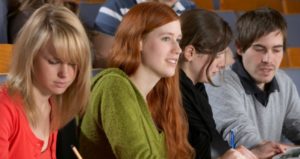
Teaching and Learning ‘Respect’ and ‘Acceptance’ in the Classroom
“I’ve learned that people will forget what you said, people will forget what you did, but people will never forget how you made them feel.”


“I’ve learned that people will forget what you said, people will forget what you did, but people will never forget how you made them feel.”

To: My Students
From: Your Teacher
Re: College and the Real World
I just read about a senior engineering student who was presenting a design project in an upper-division business communications course. In the presentation, he talked about what he would do if he were a “real” engineer. His teacher asked him what it was about what he was doing that wasn’t “real” engineering. He’d designed the project. He was presenting it to a group of his peers. He answered, “It’s school—not real engineering.”

Editor’s Note: One of the themes that emerged from our recent Teach Strats reader survey was a request for more articles specifically related to teaching in the STEM disciplines. In response, we are pleased to present an article written by true leaders in STEM education and the authors of Teaching and Learning STEM: A Practical Guide (Jossey-Bass, 2016). As its name suggests, the book focuses on the practical application of research-based strategies for designing and teaching STEM courses. It has been called “hands-down the best instruction manual for professors in science, technology, engineering, and mathematics that you can find.” [Barbara Oakley, PhD]

So, the fall semester is about to begin and you’ve decided to try something new in one or more of your courses. Maybe it’s a

Have your students ever told you that your tests are too hard? Tricky? Unfair? Many of us have heard these or similar comments. The conundrum

Consider the lessons we learn without being fully aware they are taking place. Take something simple, such as walking into a new building for the first time. With everyone and everything you observe, your mind is giving you feedback based on a multitude of judgments. These impressions, while sometimes incorrect, come to us with little effort. Yet they could loosely be considered teaching and learning without calling it either. I have found this to be a fruitful concept from a pedagogical standpoint. How many of us actively question this point to ourselves, “What am I teaching students, and what are they learning?”

Classroom spaces (virtual or physical) are special. We tend to take them for granted, partly because spaces in general have become less differentiated. We don’t do certain things in specified places like we used to. We work at home, on planes, and in various public spaces. We eat in our cars and in front of the TV. We use our devices everywhere—bathrooms, bedrooms, churches, cars, elevators, street corners, and, yes, classrooms.

Since the election of President Barack Obama, America has been pushing a false narrative of a post-racial society. The continued killings of black and brown

Prior knowledge is essential for learning because it helps us make sense of new ideas and information. But when that prior knowledge is incomplete, confused, or flawed, it can create barriers to learning. Consider the following scenarios.

As the higher education community continues to work to create a more inclusive learning environment, the needs of our gender-variant students are too often overlooked. This article outlines a few ways faculty can create an atmosphere that supports trans-identified and gender-nonconforming students.